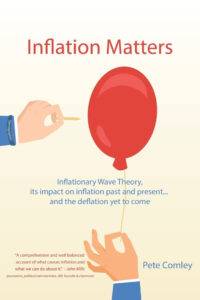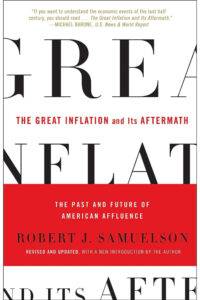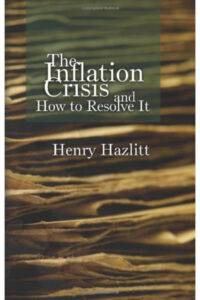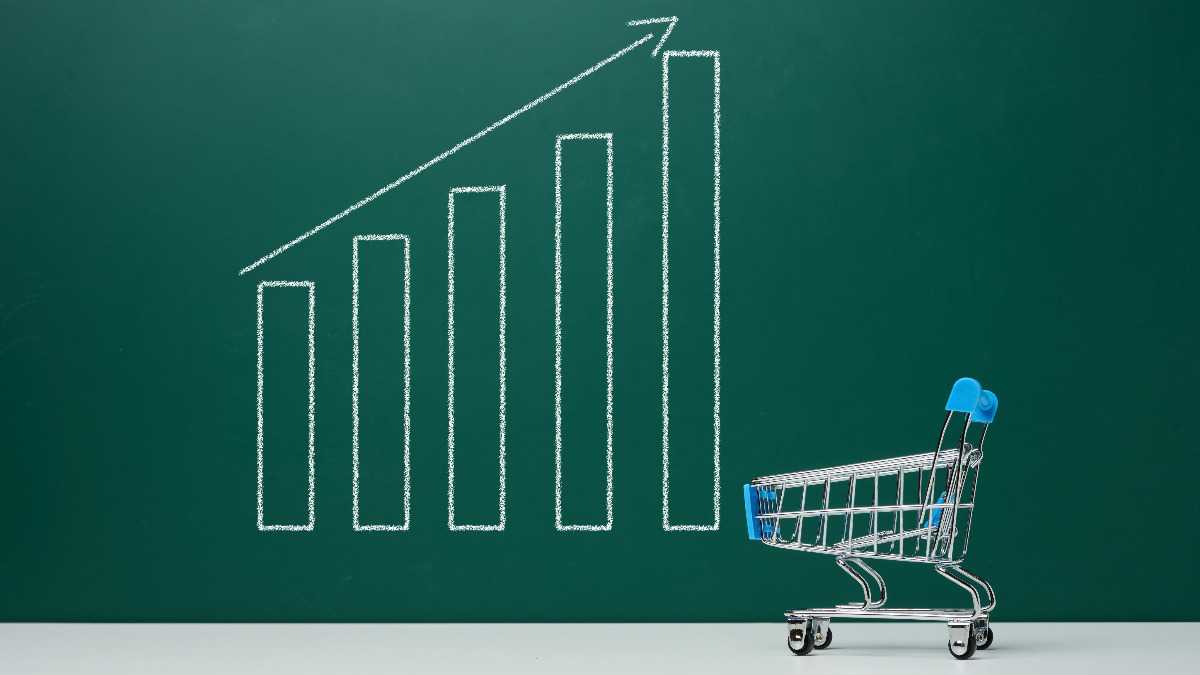Inflation, in its most basic form, is the rate at which the general level of prices for goods and services rises and, subsequently, purchasing power falls. It’s a term thrown around in the news, financial reports, and economic forecasts. But what does it mean for you in your everyday life?
Imagine you have $100 in your wallet today. You’ve noticed that this amount can buy you a specific basket of goods—say, a week’s worth of groceries. Now, let’s say the inflation rate is 2% per year. This means that next year, that same $100 will only be able to buy you 98% of the goods it could purchase today. In other words, the value of your money is eroding over time due to inflation.
Inflation is like an invisible tax that gnaws away at the value of your money. It’s a critical economic indicator that affects everyone, from the individual consumer to the largest government. It influences your decisions about spending, saving, and investing. It can impact your job, your income, and the cost of your necessities and luxuries.
Understanding inflation is about more than just grasping a fundamental economic concept. It’s about understanding a force that, over time, can change your standard of living. In the following sections, I’ll go deeper into the mechanics of inflation, its historical trends, and its impact on your everyday expenses and investments. I’ll also provide practical tips to help you cope with inflation and safeguard your financial future.
The Mechanics of Inflation
As we’ve established, inflation is the rate at which the general level of prices for goods and services is rising. But how exactly does this process work? To understand the mechanics of inflation, we need to dig into some key economic concepts and indicators, the most important of which is the Consumer Price Index (CPI).
The CPI is a measure that examines the weighted average of prices of a basket of consumer goods and services, such as transportation, food, and medical care. It is calculated by taking price changes for each item in the predetermined basket of goods and averaging them. Changes in the CPI are used to assess price changes associated with the cost of living, making it one of the most frequently used statistics for identifying periods of inflation or deflation.
Inflation occurs when there is an increase in the supply of money in an economy relative to the volume of goods and services available. When more money is chasing the same amount of goods and services, prices rise to accommodate the increased demand, leading to inflation. This can happen for various reasons, such as increased production costs, higher demand for goods and services, or government policies that increase the money supply.
There are two main types of inflation: demand-pull and cost-push. Demand-pull inflation occurs when demand for goods and services exceeds their supply. It’s the classic economic scenario of too much money chasing too few goods. On the other hand, cost-push inflation happens when the costs of production increase, causing producers to raise prices to maintain their profit margins.
Inflation is not inherently bad. Moderate inflation is often seen as a sign of a healthy, growing economy. However, hyperinflation (extremely high and typically accelerating inflation) can lead to significant economic instability. Conversely, deflation (a decrease in the general price level) can lead to an economic downturn.
Historical Perspective
As an economic phenomenon, inflation has seen significant shifts over the past several decades. Various factors have influenced these shifts, including economic activity, government policy, and global events.
The 1970s were marked by high inflation in the United States, often called the “Great Inflation.” This era was characterized by inflation rates soaring into double digits, driven by factors such as oil price shocks, loose monetary policy, and wage-price spirals. This period culminated in the early 1980s with the Federal Reserve’s aggressive tightening of monetary policy under Paul Volcker, which led to a severe recession but successfully brought inflation under control.
The mid-1980s through the early 2000s, often called the “Great Moderation,” were characterized by relatively low and stable inflation. This era was marked by increased globalization, technological advancements, and changes in monetary policy, all of which contributed to keeping inflation in check.
The financial crisis of 2008 and the subsequent Great Recession led to low inflation, even deflation in some areas, as demand for goods and services plummeted. In the years following the crisis, despite unprecedented monetary stimulus by central banks worldwide, inflation remained relatively subdued.
More recently, the economic impact of the COVID-19 pandemic, combined with significant fiscal and monetary policy responses, led to a surge in inflation rates. Consumer prices climbed 9.1 percent over the year through June 2022, marking the fastest rate of increase in four decades. However, the most recent data indicates a potential easing of these inflationary pressures. As of May 2023, the annual inflation rate for the United States was 4.0%, down from a rise of 4.9% in the previous period. This suggests that inflation may be starting to stabilize, although it remains important to monitor these trends closely.
Inflation trends can vary significantly across countries and regions, influenced by economic structure, monetary and fiscal policy, and external shocks. Understanding these historical trends and their implications is crucial for making informed financial decisions in the present.
The Impact of Inflation on Everyday Expenses
Inflation, as we’ve discussed, is the general increase in prices over time. But how does this translate to your everyday expenses? Let’s delve into the details.
Inflation’s most immediate and noticeable impact is on the cost of goods and services. As inflation rises, the purchasing power of a unit of currency—be it a dollar, euro, or yen—falls. This means that the same amount of money buys fewer goods and services.
Let’s revisit our example for groceries. If the inflation rate is 2%, a grocery bill that cost you $100 last year would cost you $102 this year. This might not seem like a big difference, but when applied to all your expenses—rent or mortgage payments, utilities, transportation, healthcare, and more—the effect compounds. Over time, even a low inflation rate can significantly erode purchasing power.
It’s also important to note that inflation doesn’t affect all goods and services equally. Some items may increase in price faster than the general rate of inflation. For instance, healthcare costs and college tuition have historically risen at rates much higher than the average CPI. On the other hand, prices for some goods, particularly technology products like computers and TVs, have actually fallen over time due to improvements in efficiency and productivity.
Inflation also impacts income. Suppose your income doesn’t increase at a rate at least equal to inflation. In that case, you’re effectively earning less in terms of purchasing power. This is why workers often seek wage increases to keep up with inflation and why it’s important for retirees to have sources of inflation-protected income.
Inflation and Investments
Inflation doesn’t just affect your everyday expenses—it also has significant implications for your investments. The impact of inflation on assets can be complex, as it can both erode and enhance investment returns, depending on the type of investment.
Let’s start with the most basic form of investment: cash. If you’re holding cash or cash equivalents, such as in a checking or savings account, inflation is your enemy. As we’ve discussed, inflation erodes the purchasing power of cash over time. If the interest rate on your account is less than the inflation rate, you’re effectively losing money in real terms.
Bonds, or fixed-income securities, are also vulnerable to inflation. When you buy a bond, you’re lending money to a government or corporation for a fixed term in exchange for regular interest payments and the return of the principal at the end of the bond’s duration. The interest rate on the bond is fixed, so if inflation rises, the real return on your bond investment falls.
Stocks, or equities, have a more complex relationship with inflation. On the one hand, inflation can be a sign of a healthy, growing economy, which is generally good for corporate profits and, therefore, for stock prices. On the other hand, high inflation can increase a company’s costs, squeeze profit margins, and lead to higher interest rates, all of which can hurt stock prices.
Real estate can be a good hedge against inflation, as property values and rental income often rise with inflation. However, rising interest rates can also affect real estate by increasing the cost of mortgages and depressing property values.
Commodities, such as gold, oil, and agricultural products, are often seen as good hedges against inflation. Their prices tend to rise when inflation is high, as demand for these tangible assets increases.
Practical Tips for Managing the Impact of Inflation
Inflation is an economic reality that can’t be avoided. However, with careful planning and strategic decision-making, you can mitigate its impact on your personal finances. Here are some practical tips to help you cope with inflation:
- Understand Your Cash Flow: Keep a close eye on your income and expenses. If your income isn’t keeping up with inflation, you may need to adjust your budget or seek additional sources of earnings.
- Invest Wisely: As we discussed in the previous section, different types of investments react to inflation in different ways. Diversification is key. A well-balanced portfolio that includes a mix of assets—such as stocks, bonds, real estate, and commodities—can help protect against inflation.
- Consider Inflation-Protected Securities: In the U.S., Treasury Inflation-Protected Securities (TIPS) are bonds that adjust with inflation, providing a reliable stream of income that keeps pace with the cost of living. Other countries offer similar inflation-linked bonds.
- Focus on Real Returns: When evaluating any investment, consider the real return—the return after accounting for inflation. A high nominal return can be eroded by inflation, resulting in a low or even negative real return.
- Adjust Your Spending: Inflation might mean some goods and services become too expensive. Be flexible and consider cheaper alternatives or cutbacks in certain areas.
- Negotiate Your Salary: If you’re employed, ensure your salary keeps up with inflation. Regular cost-of-living adjustments can help maintain your purchasing power.
- Plan for Retirement: If you’re retired or planning for retirement, consider sources of income that adjust for inflation, such as Social Security or certain types of annuities.
Inflation can be a challenge, but with these strategies, you can manage its impact on your wallet. Understanding inflation and its effects is the first step toward making informed financial decisions.
Wrapping Up
As we’ve explored in this article, inflation is a complex economic phenomenon with far-reaching implications for your money. It’s the rate at which the general level of prices for goods and services is rising, and it impacts everything from the cost of your daily cup of coffee to the returns on your investment portfolio.
We’ve delved into the mechanics of inflation, highlighting the crucial role of the Consumer Price Index (CPI) in measuring the average change over time in the prices we pay for a market basket of consumer goods and services. We’ve also explored the historical trends of inflation, from the high inflation of the 1970s to the low inflation environment of the post-financial crisis era.
We’ve analyzed how inflation impacts everyday expenses, eroding the purchasing power of your money and making goods and services more expensive. On the investment front, we’ve discussed how inflation can both reduce and enhance investment returns, depending on the type of investment.
But most importantly, we’ve covered practical tips for managing the impact of inflation on your personal finances. Understanding your cash flow, investing wisely, considering inflation-protected securities, focusing on real returns, adjusting your spending, negotiating your salary, and planning for retirement are all strategies that can help you navigate the choppy waters of inflation.
Inflation is an inescapable part of economic life, but it doesn’t have to be a menace. With knowledge, planning, and strategic decision-making, you can mitigate its impact and ensure your financial future remains secure. Remember, the key to managing inflation is understanding it. Armed with the knowledge from this article, you’re well-equipped to do just that.
Quiz Time!
To help reinforce your understanding of the concepts discussed in this article and to test your knowledge on inflation and its impact on your wallet, I’ve prepared a few questions. Take a moment to answer these questions and see how well you’ve grasped the content. The answers are provided below with a brief explanation (no peeking).
Questions
1. What is inflation?
A) The rate at which the general level of prices for goods and services is rising
B) The rate at which the stock market is increasing
C) The rate at which wages are increasing
2. True/False: Inflation only affects the cost of goods and services, not investments.
3. Which of the following is NOT a strategy for managing the impact of inflation?
A) Investing wisely
B) Ignoring changes in the cost of living
C) Planning for retirement
4. True/False: Inflation rates have been consistently high over the past few decades.
5. Which type of investment can be a good hedge against inflation?
A) Cash
B) Real estate
C) Bonds
Answers
1. A) The rate at which the general level of prices for goods and services is rising
Explanation: Inflation is an economic term that refers to an ongoing increase in prices as measured against a standard level of purchasing power. The most common measure of inflation is the Consumer Price Index (CPI).
2. False
Explanation: Inflation impacts both the cost of goods and services and the returns on investments. It erodes the purchasing power of money, which can decrease the real returns of cash and fixed-income investments. However, investments like stocks and real estate can potentially offer some level of protection against inflation because companies can raise prices and property values can increase.
3. B) Ignoring changes in the cost of living
Explanation: Ignoring changes in the cost of living is not a good strategy for managing the impact of inflation. It’s important to understand how inflation affects the cost of goods and services and to adjust your budget and spending habits accordingly. Investing wisely and planning for retirement are both strategies that can help protect against the effects of inflation.
4. False
Explanation: Inflation rates have varied over the past few decades. There have been periods of high inflation, such as the 1970s, followed by periods of low and stable inflation, and even periods of very low inflation or deflation, such as during the Great Recession.
5. B) Real estate
Explanation: Real estate can be a good hedge against inflation because property values and rental income often rise with inflation. However, real estate can also be affected by rising interest rates, which increase the cost of mortgages and can depress property values. Cash and bonds, on the other hand, are more vulnerable to inflation because their value erodes as the purchasing power of money decreases.
I hope these questions helped you reflect on the key points discussed in the article. Remember, understanding inflation and its impact on your personal finances is crucial for making informed decisions. Keep learning and stay financially savvy!
Recommended Books
In the quest to understand and navigate the complex world of inflation, knowledge is your most powerful tool. To help you deepen your understanding and equip you with valuable insights, I’ve curated a list of highly-relevant and insightful books on the subject. These books cover a range of topics, from the basics of inflation to its historical trends and practical strategies for managing its impact.
1. “Understanding Money Mechanics” by Robert Murphy: This book is recommended by the US think tank Foundation for Economic Education as “the book to read if you want to understand inflation”. It provides a simple guide on “what money is, why it originated, and how it works in the world today”.

Available as Kindle, Hardcover, or Paperback
2. “Inflation Matters” by Pete Comley: This is a comprehensive book about inflation written in a simple and easy-to-read style. The book covers everything from the basics of how inflation is defined and measured to the impact of inflation and its winners and losers.

Available as Kindle or Paperback
3. “The Great Inflation and Its Aftermath: The Past and Future of American Affluence” by Robert J. Samuelson: This book offers a detailed account of the inflationary period in the 1970s and its impact on the American economy.

Available as Kindle, Hardcover, or Paperback
4. “The Inflation Crisis, and How to Resolve It” by Henry Hazlitt: An insightful book that explains the whole range of inflation’s destructive effects and proposes a plan to stop it.

Available as Kindle, Hardcover, or Paperback
Each of these books offers a unique perspective on inflation, providing valuable insights and practical advice. Whether you’re a seasoned investor, a student of economics, or simply a concerned citizen, these books can help you understand the complex dynamics of inflation and its impact on your wallet. Remember, the key to navigating the choppy waters of inflation is understanding it, and these books are a great place to start.
Disclaimer: This article reflects the author’s opinion and is not financial advice. The author is not a licensed financial advisor. Content is for informational purposes only. Consult a qualified financial professional before making investment decisions.
This post may contain affiliate links, which means I may receive a commission if you click a link and make a purchase. However, my opinions and recommendations remain my own, uninfluenced by any potential earnings.
Enjoyed the read? Subscribe to my blog and spread the word by sharing this article with your circles!
I’d love to hear your take on the subjects we’ve covered in this post. Drop a comment or question below. Let’s keep this conversation going!

